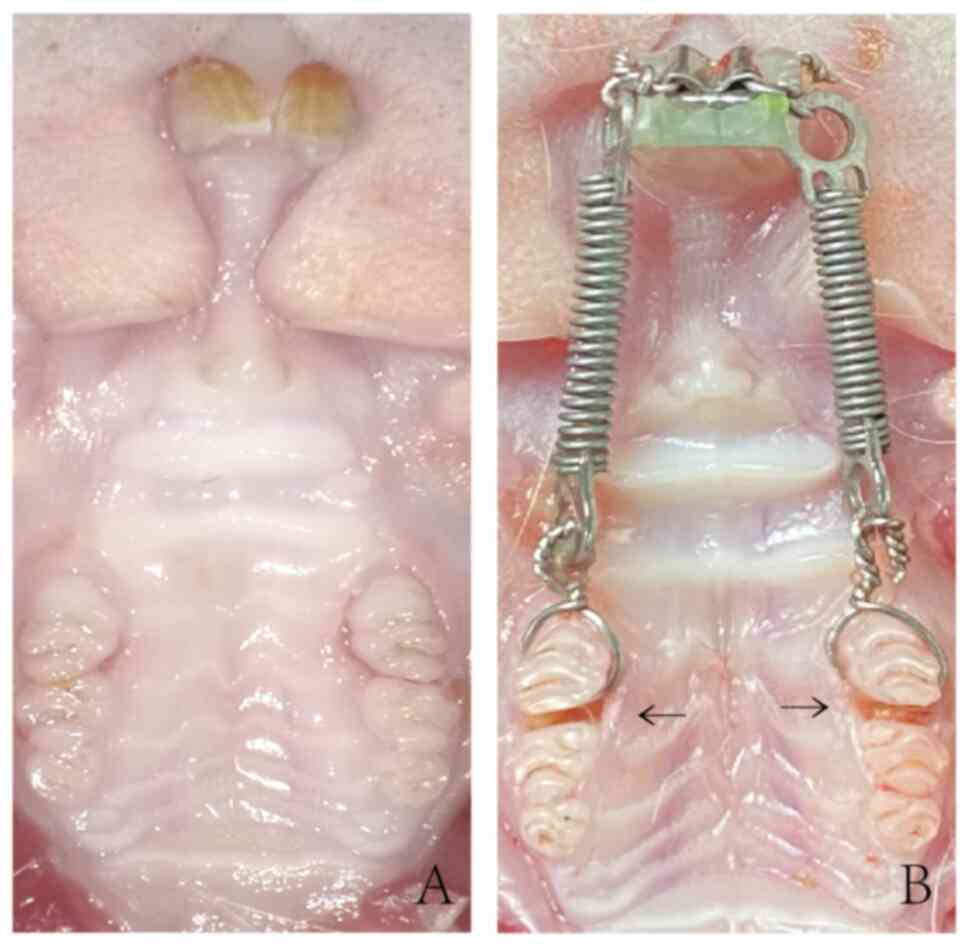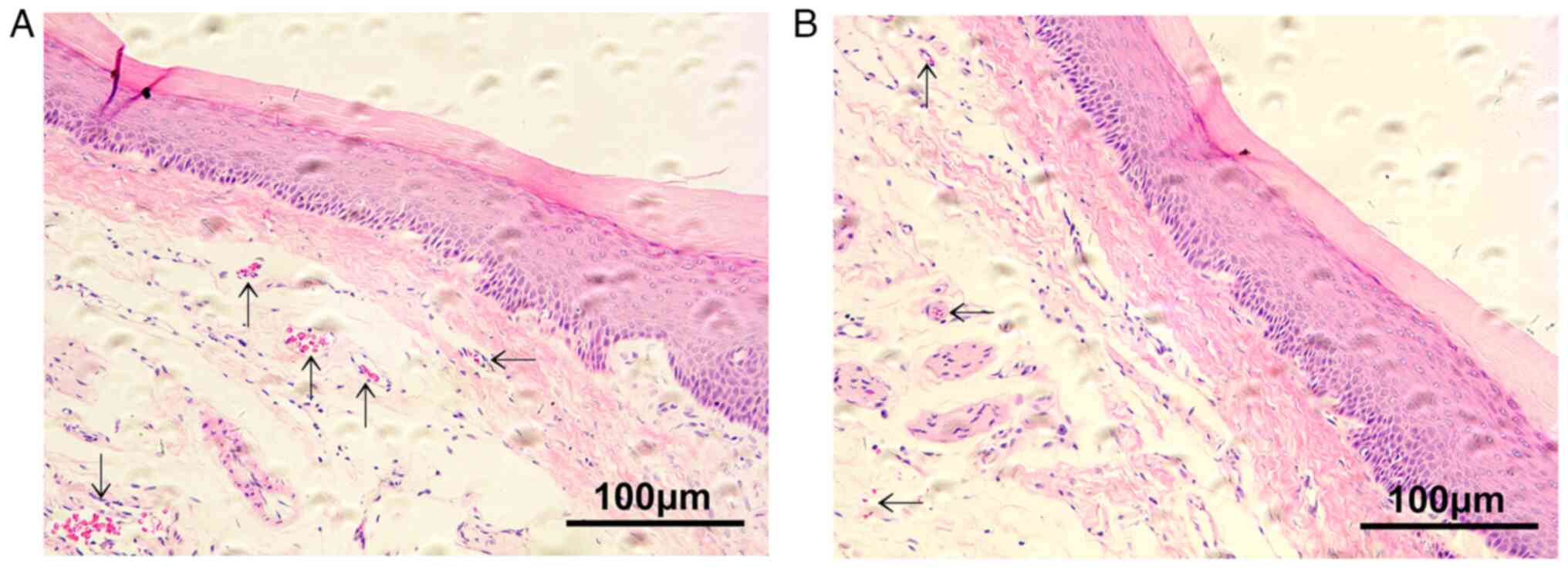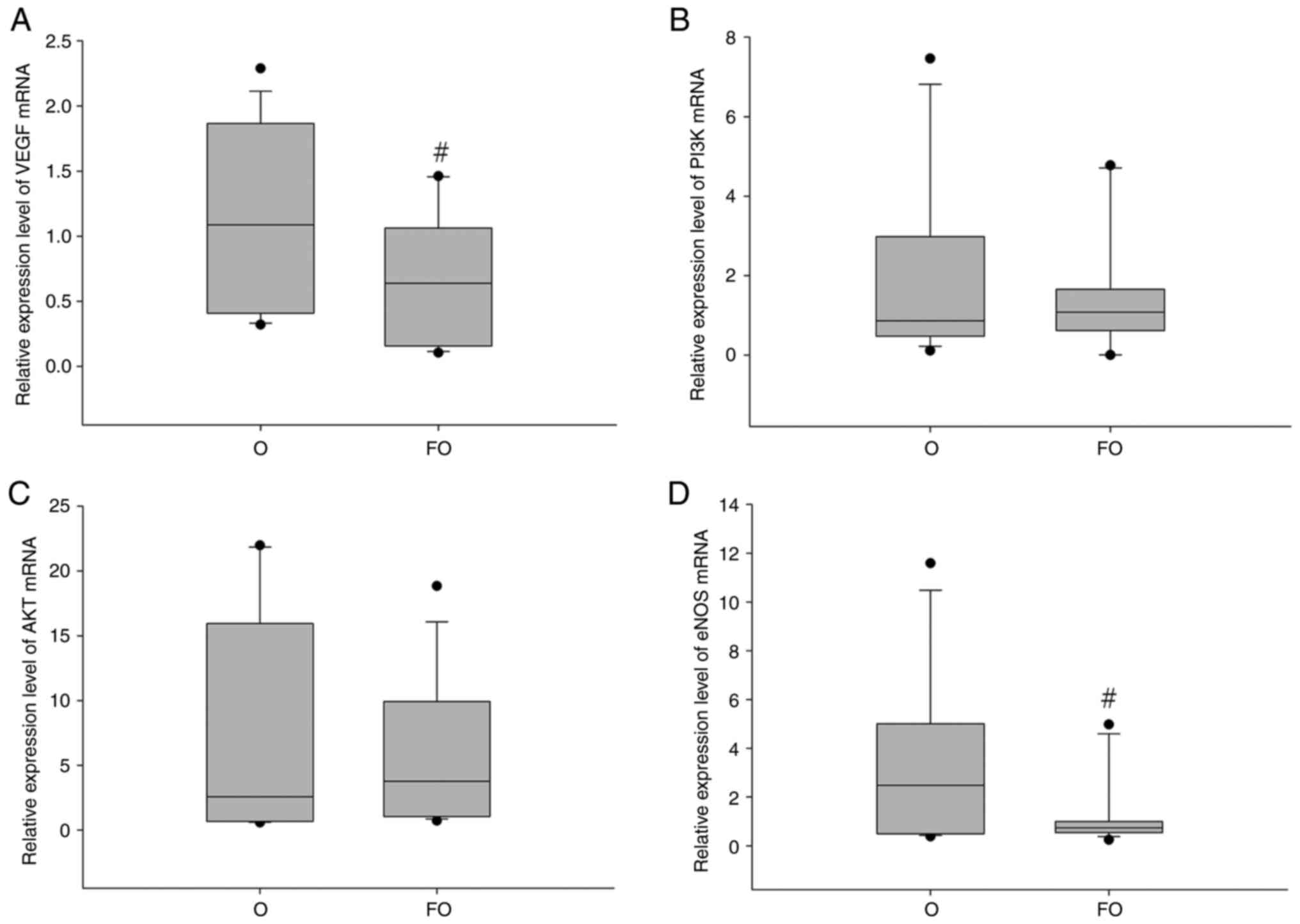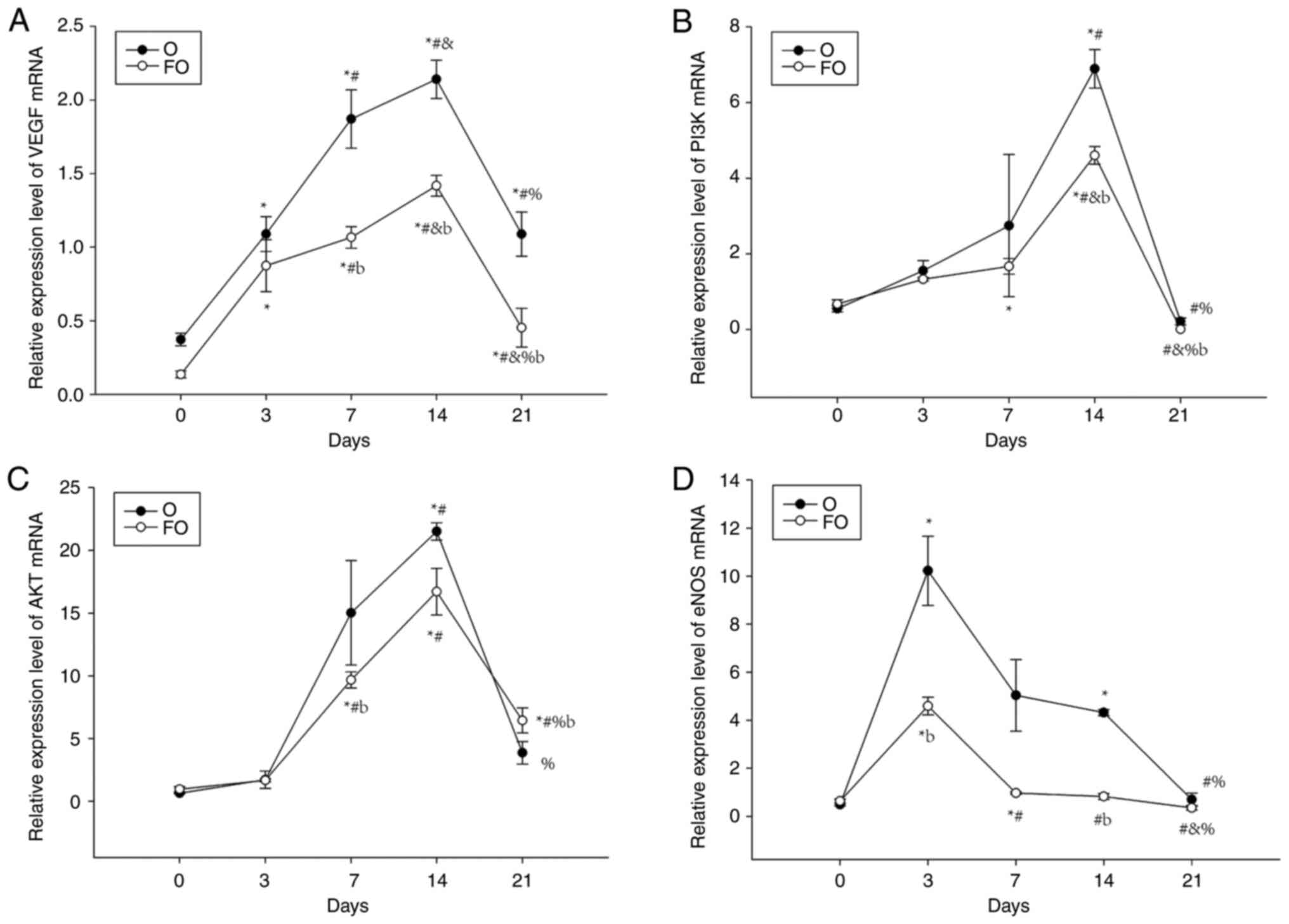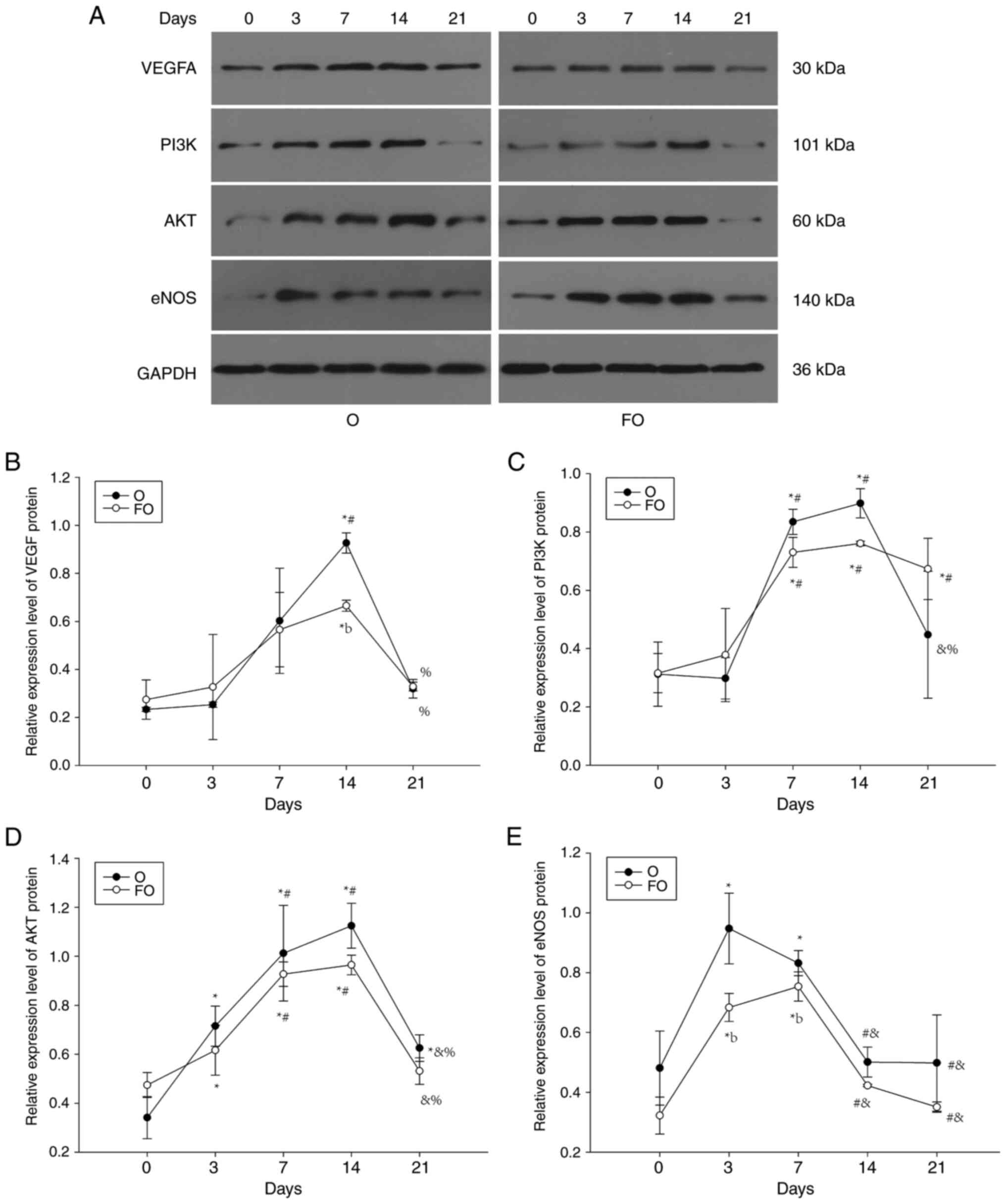Effects of chronic fluorosis on the expression of VEGF/PI3K/AKT/eNOS in the gingival tissue of rats with orthodontic tooth movement
- Authors:
- Published online on: January 31, 2024 https://doi.org/10.3892/etm.2024.12409
- Article Number: 121
-
Copyright: © Ding et al. This is an open access article distributed under the terms of Creative Commons Attribution License.
Abstract
Introduction
Studies have shown that high fluoride environments have adverse effects on soft and hard body tissues (1,2). Periodontal tissue comprises hard tissues, such as alveolar bone and cementum, as well as soft tissues, including the gingiva and periodontal ligaments (3). The biological mechanism of orthodontic tooth movement includes the conversion of mechanical force signals into biological force signals, which stimulate various growth factors in periodontal tissue, thereby promoting alveolar bone remodeling and ultimately resulting in changes in tooth movement (4,5). Therefore, exploration of the changes in periodontal tissue lesions in a high-fluoride environment may assist in the development of targeted diagnosis and treatment plans for orthodontic patients who have dental fluorosis. It has been reported that the periodontal health of individuals in high-fluoride areas has declined, and patients with dental fluorosis tend to require prolonged orthodontic treatment (6). The present research team has shown that the orthodontic tooth movement rate of rats in a high-fluoride environment slows down and the rhythm of the tooth movement cycle changes (7). The research team also observed changes in the periodontal tissue of Sprague-Dawley (SD) rats with chronic fluorosis from multiple perspectives, such as alveolar bone histology, alveolar bone microstructure, bone biomechanics, bone metabolism levels and oxidative stress (8,9). The results of these studies suggest that, during orthodontic tooth movement, fluoride exposure results in the disordered arrangement of periodontal ligament cells, increased periodontal fiber breakage, uneven distribution of vascular endothelial cells, and decreased protein expression levels of vascular endothelial growth factor (VEGF) and endothelial nitric oxide synthase (eNOS) in periodontal tissue. In addition, the gingiva participates in the organization structure of periodontal tissue and circulatory nourishment (10). The gingiva is a component of periodontal tissue with abundant blood vessels; however, it remains to be determined how the vascular response in gingival tissue manifests during orthodontic tooth movement in an environment of chronic fluorosis. Therefore, the present study aimed to investigate the effects of a high-fluoride environment on gingival angiogenesis in rats undergoing orthodontic tooth movement by detecting the protein and gene expression levels of VEGF, phosphatidylinositol-3 kinase (PI3K), AKT (also known as protein kinase B) and eNOS, which are involved in the gingival microvascular generation pathway.
Materials and methods
Laboratory animals, reagents and instruments
SPF-grade male rats (age, 3 weeks; body weight, 60±5 g) were obtained from Guizhou Medical University Experimental Animal Center [license no. SCXK (Xiang) 2019-0014]. NaF of superior purity grade was purchased from Sigma Technologies, Inc. The drinking water was tap water from Guizhou, China, in which has a fluoride ion level of 0.08 mg/kg lower compared with the Chinese national standard. Orthodontic nickel titanium tension springs (0.012 inch) were obtained from Shenzhen Suhang Technology Development Co., Ltd. Ti-Ni brackets were obtained from Hangzhou Jiali Trading Co., Ltd. The hematoxylin and eosin (H&E) staining kit (cat. no. G1120) was purchased from Beijing Solarbio Science & Technology Co., Ltd., the SYBR Green Master Mix kit was from Vazyme Biotech Co., Ltd., the RIPA lysis buffer (cat. no. HJ202804) was from Wuhan Servicebio Technology Co., Ltd., the Total RNA Extraction kit (cat. no. R1200) was from Beijing Solarbio Science & Technology Co., Ltd., theRevertAid First Strand cDNA Synthesis kit (cat. no. K1622) was from Thermo Fisher Scientific, Inc., the protease inhibitor cocktail (cat. no. 4693132001) was from Merck KGaA and the microscope (XSP-C204) was from Chongqing Liuhui Technology Co., Ltd. The following antibodies were also used: Anti-VEGF (cat. no. AF5131; Affinity Biosciences), anti-PI3K (cat. no. abs148658; Absin Bioscience, Inc.), anti-AKT (cat. no. C67E7; Cell Signaling Technology, Inc.), anti-eNOS (cat. no. AF0096; Affinity Biosciences), anti-GAPDH (cat. no. ab8245; Abcam), TBST solution (cat. no. G0004; Wuhan Servicebio Technology Co., Ltd.) and horseradish peroxidase-conjugated secondary antibody (cat. no. E-AB-1003; Elabscience Biotechnology, Inc.), ECL (cat. no. 170-5060; Bio-Rad Laboratories, Inc.). In addition, a CFX Connect Real-Time PCR detection system from Bio-Rad Laboratories, Inc., a refrigerated centrifuge (Microfuge 20R) from Beckman Coulter, Inc., an electrophoresis instrument (DYY-6C) from Beijing Liuyi Biotechnology Co., Ltd., a microplate reader (SMR16.1) from USCN Kit, Inc., a QuickChemi Imager (QuickChemi 5100) from Monad Biotech Co., Ltd., and ImageJ 1.53 software (Bio-Rad Laboratories, Inc.) were used.
Group design and experimental methods
In a laboratory room with temperature 22-24˚C, humidity 55-60%, alternating light and dark lighting environment for 12 h. The 60 SD rats were divided into the orthodontic group (O group) and the fluorosis orthodontic group (FO group), with 30 rats per group. In the FO group, 150 mg/l NaF aqueous solution was administered to the rats daily for 3 months. Subsequently, all rats in both groups were equipped with a nickel-titanium tension spring orthodontic force-applying device as follows: The rats were intraperitoneally injected with 2% sodium pentobarbital (30 mg/kg) and fixed on a fixator; acid etching of the labial surfaces of the maxillary mesial incisors was performed for 1 min; adhesive was applied and Ti-Ni brackets were bonded to the surfaces of the teeth with green orthodontic adhesive by light fixing. A 0.25-mm ligature wire was threaded through the gap adjacent to the first two molars, and ligated and fixed to one end of a binaural tension spring. The other end of the tension spring was ligated and fixed to the anterior bracket of the device. After the application of the device, the rats were fed a soft diet, and the device was inspected daily to ensure that it remained in place for the duration of the study. The bilateral maxillary first molars were moved mesially with 70-g force, and each group was divided into 0-, 3-, 7-, 14- and 21-day groups (each n=6) according to the duration of orthodontic force application. A total of six rats from each group were placed in the same metabolic cage, with 240 ml of tap water (O group) or NaF aqueous solution (FO group) and 240 g of feed per cage per day. All rats were sacrificed after reaching the time point appropriate for their group. The rats were intraperitoneally injected with 2% sodium pentobarbital (30 mg/kg) and sacrificed by exsanguination. Blood and urine samples were collected for the measurement of fluoride ion levels by the fluoride ion selective electrode method. Gingival tissue samples were also taken to prepare specimen sections for H&E staining, reverse transcription-quantitative polymerase chain reaction (RT-qPCR) and western blot analysis.
H&E staining
The gingival tissue samples were dehydrated, embedded, cut into 5-µm tissue slices, routinely deparaffinized with xylene and dehydrated with a gradient alcohol series. The sections were then stained with hematoxylin for 4 min at 35˚C, after which they were rinsed with tap water, soaked in 1% hydrochloric acid alcohol for 3 sec, rinsed with tap water, soaked in 1% aqueous ammonia for 3 sec and rinsed with tap water again. After soaking in 85-90-95% alcohol for 5 min per percentage, they were then stained with eosin for 4 min at 35˚C. Finally, the sections were dehydrated with a routine gradient alcohol series, permeabilized with xylene, sealed with neutral gum and observed under an optical light microscope.
RT-qPCR
Total ribonucleic acid (RNA) was extracted from the gingival tissue samples according to the instructions of the Total RNA Extraction kit, after which the extracted RNA was reverse transcribed into complementary deoxyribonucleic acid (cDNA) according to the instructions of the RevertAid First Stand cDNA kit. The cDNA was subjected to qPCR using the 20-µl amplification reaction system from the SYBR Green Master Mix kit and the following reaction conditions: Denaturation at 95˚C for 3 min, followed by 40 cycles at 95˚C for 15 sec and 60˚C for 1 min. The relative expression levels of mRNA were analyzed using the 2-∆∆Cq method (11). The primer sequences used are shown in Table I.
Western blotting
Tissues were added to a solution comprising RIPA lysis buffer and protease inhibitor cocktail, and lysed by incubation in an ice bath for 60 min. After centrifugation at 12,000 x g for 5 min at 4˚C, the supernatant was collected and the protein content was quantified using the bicinchoninic acid method by microplate reader. The proteins were separated by sodium dodecyl sulfate polyacrylamide gel electrophoresis (10 µg per lane; 10% separation gel and 5% concentrated gel) and transferred to polyvinylidene fluoride membranes, which had been blocked with 5% skimmed milk at 20˚C for 1 h. Then, the membranes were incubated with anti-VEGF, PI3K, AKT, eNOS and GAPDH primary antibodies (1:1,000) at 4˚C for 20 h. then washed the membrane with TBST solution for 5 times, 5 min each time. followed by the horseradish peroxidase-labeled secondary antibody (1:3,000) at 37˚C for 1 h. Finally, the membranes were placed in ECL and developed in the dark and visualized using QuickChemi Imager. Quantification of western blot results was performed using ImageJ software.
Statistical analysis
The experimental data were statistically analyzed using SPSS 26.0 statistical software (IBM Corp.). Normally distributed data are presented as the mean ± standard deviation and non-normally distributed data are presented as the median (interquartile interval). The unpaired t-test was used to compare normally distributed data between two groups, whereas a Mann-Whitney U test was used to analyze data that were not normally distributed. Two-way ANOVA and the Bonferroni post hoc test were used to compare multiple groups. P<0.05 was considered to indicate a statistically significant difference.
Results
Fluorosis model identification
After 3 months of fluoride feeding, the rats in the FO group exhibited dental fluorosis, which presented as yellowish-white teeth with chalky streaks (Fig. 1). In addition, the concentrations of fluoride ions in the blood and urine were significantly increased in the FO group compared with those in the O group (Table II).
Table IIFluoride ion concentration in the serum and urine of rats (mean ± standard deviation; n=20). |
Orthodontic tooth movement model identification
Following orthodontic tooth movement, a gap could be observed between the maxillary bilateral first and second molars in the rats (Fig. 2), indicating that the first molar was moved in the direction of the load and the tooth movement model was successfully established.
H&E staining of gingival tissue
The blood vessel distribution in the O group was relatively uniform, with large lumens. By contrast, the blood vessel distribution in the FO group was sparse with smaller lumens and less evident endothelial cells compared with those in the O group (Fig. 3).
Average mRNA expression levels of VEGF, PI3K, AKT and eNOS over all the time points
The average mRNA expression levels of VEGF and eNOS were significantly reduced in the FO group compared with those in the O group. These findings suggested that chronic fluorosis inhibits gingival VEGF and eNOS mRNA expression during orthodontic tooth movement (Fig. 4).
Average protein expression levels of VEGF, PI3K, AKT and eNOS over all the time points
The overall protein expression levels of AKT and eNOS were decreased in the FO group compared with the O group, but a statistically significant difference was only observed for eNOS. These findings indicated that chronic fluorosis inhibits the protein expression levels of eNOS in the gingiva during orthodontic tooth movement (Fig. 5).
Expression profiles of VEGF, PI3K, AKT and eNOS mRNA over time
The gingival tissue mRNA expression levels of VEGF, PI3K, AKT and eNOS in the O group exhibited large fluctuations with increasing time, showing an increasing and then decreasing trend. The peak in eNOS expression appeared the earliest, on day 3, whereas VEGF, PI3K and AKT expression peaked on day 14. The expression levels at the peaks were statistically different when compared with the expression levels at time points before and after the peaks. The variation in VEGF, PI3K, AKT and eNOS mRNA expression over time in the FO group was consistent with that in the O group, increasing at first and then decreasing, and the peaks appeared at the same time points as those of the same mRNA in the O group. When the two groups were compared at the same time points, VEGF, PI3K, AKT and eNOS mRNA expression in the FO group was lower than that in the O group on days 7 and 14, and there were significant differences in the expression of mRNA for VEGF and AKT on day 7, and VEGF, PI3K and eNOS on day 14 (Fig. 6).
Expression profiles of VEGF, PI3K, AKT and eNOS protein over time
The protein expression levels of VEGF, PI3K, AKT and eNOS in the gingival tissue of the O group showed a trend consistent with that of mRNA expression over time, increasing at first and then decreasing. The peak in eNOS expression appeared earliest, on day 3, whereas the peaks in VEGF, PI3K and AKT expression appeared on day 14, with statistically significant differences between the expression levels at the peak and those at the pre- and post-peak time points. The effect of time on VEGF, PI3K, AKT and eNOS protein expression in the FO group was consistent with that in the O group, showing a trend of first increasing and then decreasing. The time at which expression peaked was also similar to that in group O, with VEGF, PI3K and AKT peaking on day 14, and eNOS peaking on day 7. Statistically significant differences were identified between the expression values at the peak and at time points before and after the peak. When compared at the same time point, the protein expression levels of VEGF, PI3K, AKT and eNOS were lower in the FO group than those in the O group on days 7 and 14, and there were significant differences in the expression of protein for eNOS on day 7, and VEGF on day 14 (Fig. 7).
Discussion
Fluorine is an essential trace element in the human body; however, the long-term excessive intake of fluorine can lead to fluorosis. Chronic fluorosis, a type of systemic chronic cumulative poisoning, can damage various tissues, organs and systems of the body, and induce vascular damage (12,13). Wu et al (14) studied the mRNA expression levels of methyltransferase and mismatch repair genes in the blood cells of rats with chronic fluorosis, and found that they were significantly reduced compared with those of control rats, indicating that excessive fluoride may inhibit the DNA repair function of blood cells, thus leading to vascular damage.
A high-fluoride environment has been shown to inhibit the expression of molecules in the VEGF/PI3K/AKT/eNOS pathway. Huang et al (15) treated human umbilical vein endothelial cells with 1.2 µg/ml sodium fluoride for 24 h, and evaluated the level of nitric oxide (NO) in the culture medium, and the protein levels of eNOS, phosphorylated (p)-eNOS, PI3K, AKT and p-AKT. The results suggested that excess fluoride exposure inhibited NO synthesis and that the PI3K/AKT/eNOS pathway played a key role in the reduction of NO expression.
It has previously been shown that under the action of orthodontic treatment force, local ischemia and hypoxia in periodontal tissues can cause the upregulation of VEGF, which in turn increases angiogenesis (16). The binding of VEGF to tyrosinase receptors on the surface of endothelial cells activates intracellular PI3K, which subsequently activates AKT. Furthermore, the phosphorylation of AKT activates the eNOS that is distributed in vascular endothelial cells, and activated eNOS produces NO in the vasculature, which assists vascular endothelial cell outgrowth, proliferation and migration, and promotes vascular neovascularization (17).
When chronic fluorosis is present, it has not yet been determined how orthodontic force affects the angiogenesis of periodontal tissue. Our previous study found that during orthodontic tooth movement in rats with chronic fluorosis, the number of microvessels in the periodontal ligament near the alveolar bone decreased, and the expression of VEGF and eNOS in the periodontal tissue was significantly lower than that in the control group without fluorosis (18). Similar changes were observed in gingival tissue in the present study. The present study also found that the expression of VEGF, PI3K, AKT and eNOS in the gingiva was inhibited, indicating that angiogenesis activity was weakened in rats undergoing orthodontic tooth movement in a high-fluoride environment, which suggests that the fluoride-induced damage of gingival blood vessels might be associated with the slowdown of orthodontic tooth movement.
The present study also found that chronic fluorosis had a more marked inhibitory effect on gingival VEGF and eNOS expression than on other analytes. As upstream and downstream signaling molecules of the angiogenesis pathway, significant changes in their expression may occur as a sensitive response to fluoride ion stimulation. VEGF serves to create the initiation signal of the pathway, causing downstream reactions (19), whereas eNOS ultimately produces NO, thus promoting angiogenesis (20). The synchronous expression of VEGF and eNOS in response to excessive fluoride ions may be considered to indicate the relatively stable expression of this vascular pathway in the mechanism of gingival fluorosis.
Under conditions of chronic fluoride toxicity, in the present study, the expression of VEGF, PI3K, AKT and eNOS, which are regulators of gingival angiogenesis in rats, was inhibited at the mRNA and protein levels, and the trends were very similar. However, there were some differences in the degree of inhibition, and the reduction in mRNA expression was more marked. It is suggested that inhibition of the PI3K vascular pathway by excess fluoride ions may be interfered with by multiple factors, leading to the inhibition of protein function being weakened and delayed. Therefore, it is necessary to conduct an in-depth analysis on the regulation of this vascular pathway in future studies to elucidate the intrinsic mechanism underlying the inhibition of neovascularization induced by fluoride toxicity.
Orthodontic tooth movement has a cyclic pattern of change, which generally comprises three stages (21). Stage 1 is the initial movement of the tooth within the periodontal membrane and supporting bone tissues, which results mainly in elastic changes in the periodontal membrane and mechanical displacement of the tooth. In addition, the blood vessels in the periodontal membrane are squeezed and pulled, the lumen becomes thinner and the blood flow is reduced, thereby reducing the local oxygen concentration and promoting vascularization. This stage lasts for 1-3 days. Stage 2 refers to the delayed stage of degeneration, where the elastic deformation of the periodontal membrane reaches its limit, the local oxygen concentration decreases to the minimum and vitreous tissue appears. In addition, periodontal tissue undergoes active remodeling, active vascularization occurs and the neovascularization extends into the vitreous tissue and finally clears it. This stage generally lasts for 2-3 weeks. Stage 3 is when the removal of the vitreous tissue is completed, the periodontal membrane stress is released, blood circulation improves, vascularization is reduced to normal and the tooth enters the stage of continuous movement. Periodontal tissue resorption alternates with new growth, and the dynamic balance of tissue remodeling is maintained. This remodeling process has been shown to be dependent on the periodontal tissue vascularization response (22). The observation time points of the present study were designed using the tooth movement cycle as a reference, in an attempt to observe the potential relationship between changes in the temporal effect of gingival vascularization and orthodontic tooth movement.
The results of the present study showed that there was a certain temporal rhythm in the mRNA and protein expression levels of VEGF, PI3K, AKT and eNOS in the gingiva of the O and FO groups, which corresponded with the vascular response during the tooth movement cycle. The gene and protein expression levels of VEGF, PI3K, AKT and eNOS in the gingiva of the O group began to increase after the application of stress, and then decreased once they had reached their peak. This finding indicates that, after being stimulated by orthodontic force, the body triggers a vascular response, and as time goes on and the mechanical force stimulation persists, the vascular response intensifies and hyalinization occurs. Afterwards, as the glassy tissue is cleared, the vascular response gradually weakens and eventually reduces to normal. The trends observed with fluoride exposure in the FO group were basically consistent with those in the O group, showing an upward and then downward trend, but the upward and downward changes in amplitude occurred more slowly and the peak expression levels were lower than those in group O. This suggests that fluorosis interferes with the vascular remodeling of orthodontic tooth movement during the delayed tooth movement period, reduces vascular reactivity, prolongs the duration of vascular remodeling, and may prevent the complete removal of glassy tissue, which has a negative impact on the stability of orthodontic tooth movement (23).
The peak eNOS expression on days 3 and 7 in the O and FO groups occurred earlier than the peak expression of VEGF, PI3K and AKT on days 7 and 14. This may be attributed to the negative association between eNOS and vasoactivity, with eNOS significantly elevated when the blood vessels were only slightly stimulated during the early stage of orthodontic tooth movement, and suppressed with the prolongation of the force application and the continuous intensification of stress stimulation. In addition, the changes in the expression of VEGF, PI3K, AKT and eNOS pathway molecules over time were not completely consistent with each other, likely because PI3K/AKT not only promotes vascular remodeling during tooth movement as a downstream signaling molecule of VEGF but also participates in other signaling pathways to regulate activities such as osteogenesis and osteoblastogenesis, which are closely associated with cell proliferation, migration and differentiation, and protein synthesis (24).
Gingival tissue covers the alveolar bone cortex, which is different from periodontal ligament tissue and is not directly associated with alveolar bone remodeling during orthodontic tooth movement. Therefore, previous studies have focused more on changes to the alveolar bone and periodontal ligament tissue. The present study revealed that the gingival component of periodontal tissue is rich in fibrous tissue and may be susceptible to fluoride. It is likely to cause persistent fluoride accumulation in periodontal bone tissue by connecting the periodontal bone tissue with saliva and the high-fluoride environment of the whole body through rich microcirculation channels; this has been confirmed in the previous research of the present study group (9). Therefore, it is necessary to further explore the possible role of gingival fluorosis injury in orthodontic tooth movement in future studies.
Acknowledgements
Not applicable.
Funding
Funding: The study was supported by the National Natural Science Foundation of China (grant no. 81860795).
Availability of data and materials
The datasets used and/or analyzed during the present study are available from the corresponding author on reasonable request.
Authors' contributions
YJ designed the experiments. XD and LL established the orthodontic tooth movement model. XL and JH performed immunohistochemistry and H&E staining. JH and WC were responsible for RT-qPCR and western blotting. YJ, XD, LL, XL, WC and JH confirm the authenticity of all the raw data. All authors read and approved the final version of the manuscript.
Ethics approval and consent to participate
The study was approved by the Ethics Committee of Guizhou Medical University (Guiyang, China; approval no. 2000890).
Patient consent for publication
Not applicable.
Competing interests
The authors declare that they have no competing interests.
References
|
Srivastava S and Flora SJS: Fluoride in drinking water and skeletal fluorosis: A review of the global impact. Curr Environ Health Rep. 7:140–146. 2020.PubMed/NCBI View Article : Google Scholar | |
|
Meena L and Gupta R: Skeletal fluorosis. N Engl J Med. 385(1510)2021.PubMed/NCBI View Article : Google Scholar | |
|
Vandana KL, Srishti Raj B and Desai R: Dental fluorosis and periodontium: An original research report of in vitro and in vivo institutional studies. Biol Trace Elem Res. 199:3579–3592. 2021.PubMed/NCBI View Article : Google Scholar | |
|
Yue Y, Chen Z, Xie B and Yao HL: Expression of vascular endothelial growth factor in periodontal tissues during orthodontic tooth movement and its role in bone remodeling. Shanghai Kou Qiang Yi Xue. 27:18–21. 2018.PubMed/NCBI(In Chinese). | |
|
Narimiya T, Wada S, Kanzaki H, Ishikawa M, Tsuge A, Yamaguchi Y and Nakamura Y: Orthodontic tensile strain induces angiogenesis via type IV collagen degradation by matrix metalloproteinase-12. J Periodontal Res. 52:842–852. 2017.PubMed/NCBI View Article : Google Scholar | |
|
Wang XQ, Zheng LL and Ma HF: The effect of dental fluorosis on its tooth movement distance and extraction wound alveolar bone remodeling during orthodontic extraction treatment. Chin J Endemic Dis Control. 33:393–394. 2018. | |
|
Ding X, Jia Y, Liu C, Yang SR, Lai LY, Yang H and Ding Q: Changes in displacement and rate of orthodontic tooth movement in SD rats with chronic fluorosis. Chin J Tissue Eng Res. 26:4687–4692. 2022. | |
|
Lai LY, Jia Y, Ding X, Hu J and Chen B: Changes in the internal environment and shear mechanical properties of the jawbone in SD rats exposed to fluoride at different stages. Environ Occup Med. 40:95–100. 2023. | |
|
Yang S, Liu C, Ding Q, Yang H and Jia Y: Comparative study on fluoride accumulation in hard tissue of rats with chronic drinking-water-borne fluorosis. J Environ Occup Med. 39:174–178. 2022. | |
|
Liu Y, Li CX, Nie J, Mi CB and Li YM: Interactions between orthodontic treatment and gingival tissue. Chin J Dent Res. 26:11–18. 2023.PubMed/NCBI View Article : Google Scholar | |
|
Livak KJ and Schmittgen TD: Analysis of relative gene expression data using real-time quantitative PCR and the 2(-Delta Delta C(T)) method. Methods. 25:402–408. 2001.PubMed/NCBI View Article : Google Scholar | |
|
Dey Bhowmik A, Das T and Chattopadhyay A: Chronic exposure to environmentally relevant concentration of fluoride impairs osteoblast's collagen synthesis and matrix mineralization: Involvement of epigenetic regulation in skeletal fluorosis. Environ Res. 236(116845)2023.PubMed/NCBI View Article : Google Scholar | |
|
Miranda GHN, Gomes BAQ, Bittencourt LO, Aragão WAB, Nogueira LS, Dionizio AS, Buzalaf MAR, Monteiro MC and Lima RR: Chronic exposure to sodium fluoride triggers oxidative biochemistry misbalance in mice: Effects on peripheral blood circulation. Oxid Med Cell Longev. 2018(8379123)2018.PubMed/NCBI View Article : Google Scholar | |
|
Wu CX, Wang YH, Li Y, Guan ZZ and Qi XL: Changes of DNA repair gene methylation in blood of chronic fluorosis patients and rats. J Trace Elem Med Biol. 50:223–228. 2018.PubMed/NCBI View Article : Google Scholar | |
|
Huang Y, Sun M, Li F, Li H and Jiang Z: Preliminary study of mechanisms of fluoride-induced suppression of nitric oxide synthesis in human umbilical vein endothelial cells. Biol Trace Elem Res. 185:311–315. 2018.PubMed/NCBI View Article : Google Scholar | |
|
Noguchi T, Kitaura H, Marahleh A, Ohori F, Nara Y, Pramusita A, Kinjo R, Ma J, Kanou K and Mizoguchi I: Tumor necrosis factor-α enhances the expression of vascular endothelial growth factor in a mouse orthodontic tooth movement model. J Dent Sci. 17:415–420. 2022.PubMed/NCBI View Article : Google Scholar | |
|
Lu JM, Zhang ZZ, Ma X, Fang SF and Qin XH: Repression of microRNA-21 inhibits retinal vascular endothelial cell growth and angiogenesis via PTEN dependent-PI3K/Akt/VEGF signaling pathway in diabetic retinopathy. Exp Eye Res. 190(107886)2020.PubMed/NCBI View Article : Google Scholar | |
|
Li C, Zhou XY, Yang SR, Li ZW and Jia Y: Mechanism and cross-talk of signaling pathways associated with bone damage in fluorosis. J Environ Occup Med. 38:794–800. 2021. | |
|
Tao X, Liu K, Li W, Zhao S, Liu C, Dai Q, Dong T, Wei P, Duan J, Wang J and Xi M: Saponin of Aralia taibaiensis promotes angiogenesis through VEGF/VEGFR2 signaling pathway in cerebral ischemic mice. J Ethnopharmacol. 317(116771)2023.PubMed/NCBI View Article : Google Scholar | |
|
Chen T, Chen H, Fu Y, Liu X, Huang H, Li Z and Li S: The eNOS-induced leonurine's new role in improving the survival of random skin flap. Int Immunopharmacol. 124(111037)2023.PubMed/NCBI View Article : Google Scholar | |
|
Jeon HH, Teixeira H and Tsai A: Mechanistic insight into orthodontic tooth movement based on animal studies: A critical review. J Clin Med. 10(1733)2021.PubMed/NCBI View Article : Google Scholar | |
|
Li Y, Zhan Q, Bao M, Yi J and Li Y: Biomechanical and biological responses of periodontium in orthodontic tooth movement: Up-date in a new decade. Int J Oral Sci. 13(20)2021.PubMed/NCBI View Article : Google Scholar | |
|
Jiang Y, Guan Y, Lan Y, Chen S, Li T, Zou S, Hu Z and Ye Q: Mechanosensitive piezo1 in periodontal ligament cells promotes alveolar bone remodeling during orthodontic tooth movement. Front Physiol. 12(767136)2021.PubMed/NCBI View Article : Google Scholar | |
|
Wang Y, Lu YH, Tang C, Xue M, Li XY, Chang YP, Cheng Y, Li T, Yu XC, Sun B, et al: Calcium dobesilate restores autophagy by inhibiting the VEGF/PI3K/AKT/mTOR signaling pathway. Front Pharmacol. 10(886)2019.PubMed/NCBI View Article : Google Scholar |




